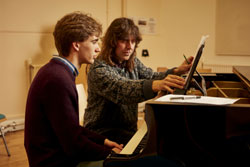
“Gamelan Storm” (2022) is a short experimental orchestral work composed as part of my MA composition dissertation portfolio. It was awarded the J.H. Britton Prize for best composition of the year.
Thank you to all my music tutors at the University of Bristol for their inspiration, guidance, and support in achieving this extended Indonesian-inspired project.
Click here for a preview of the full score. A digital recording demo of the work is available for listening below.
I am currently looking for an orchestra to premiere the work live. Please get in touch if you are interested.
Programme Note
“Gamelan Storm” fuses Balinese Gamelan idioms with twentieth century serialist technique and minimalist influences. Inspired by ritual Lelambatan structure, the music follows the passing of a violent storm over the Indonesian island of Bali. An Alto Flute solo sets the scene before cascading raindrops of strings, windy winds and percussive lightening bursts flurry into the music. This creates a seismic effect on the original five-note Pélog based tonality, which is left thoroughly overturned by the time the storm disappears.
Full Analysis
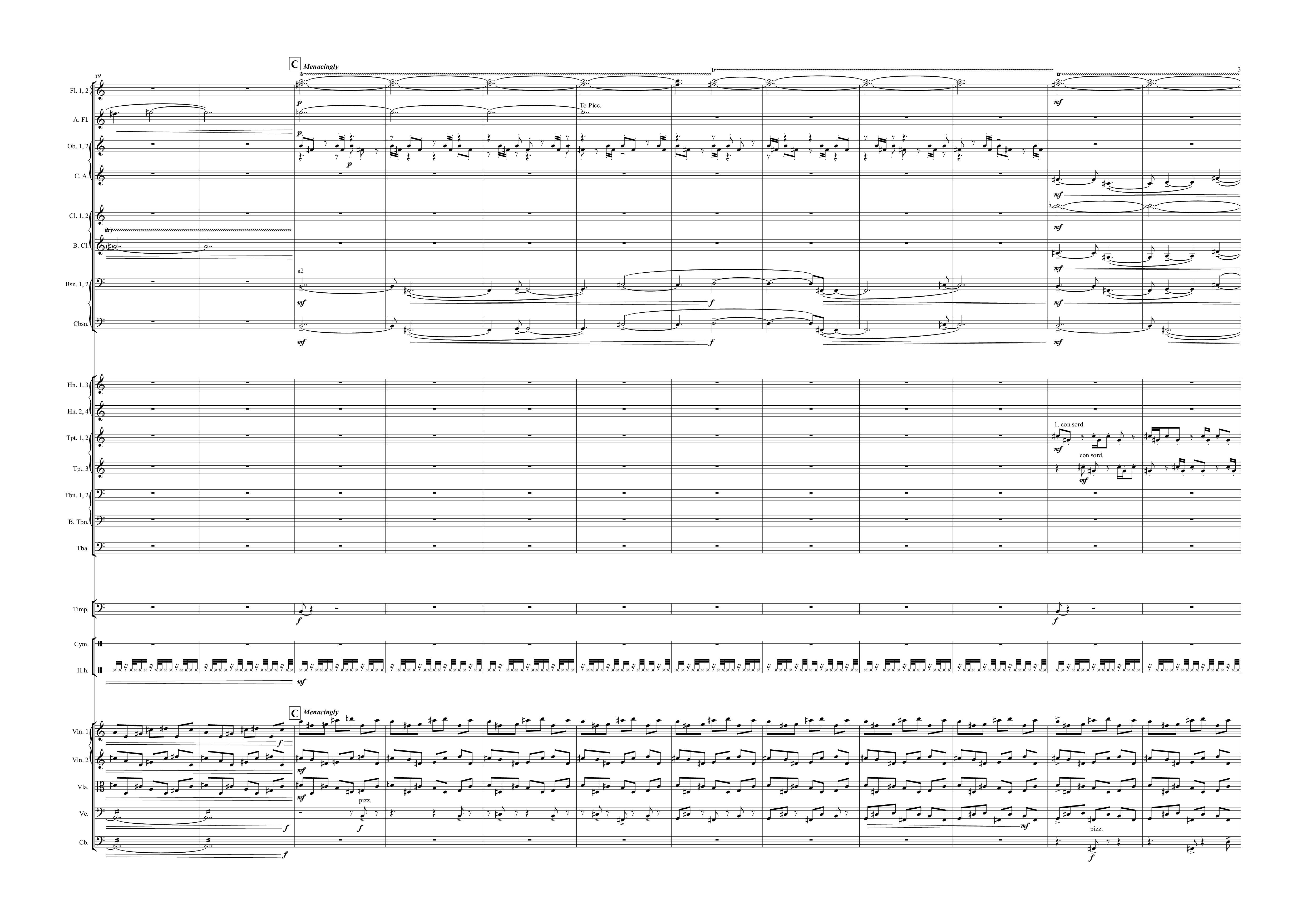
The harmonic and tonal centre of the piece is the tembung mode (A-B-C-E-F), which is a five-note derivation from the Balinese Gamelan Pélog seven-note system. I develop this mode using serial rotations, retrogrades, inversions and retrograde inversions, as well as through creating a tone row. Tenzer notes that the contrasting angular and conjunct intervals within a mode create distinctive tonal character, so my row balances this movement to reflect the agitation and unpredictability of the storm. Furthermore, my use of overlap between these rows represents the Gamelan technique of ‘Beating’, where pairs of instruments are tuned slightly apart to create an agitated tonal effect.
Lelambatan is a family of Balinese classical instrumental compositions performed primarily in the temple to entertain visiting deities. “Gamelan Storm” takes these structures to shape the form of the piece.
The first minute of the music (written using proportional notation) is influenced by the traditional austere and meditative introduction for the trompong. I write for solo Alto Flute, which introduces the melody of the ‘Bali’ motif, varied with different length pauses alluding to the free time feel of the music.
In traditional Lelambatan, this is then followed by the drums. However, in my music, these are represented by the col legno strings, which portray raindrops and paint the picture of a dry landscape. The row is introduced by the minimalist technique of note addition:
- Violin 1 begins in bar 2, following the pattern 1742635.
- Violin 2 begins in bar 9, following the reverse pattern 53624671 but metrically displaced forwards by 1 quaver beat.
- Viola begins in bar 16, following the original pattern but metrically displaced forwards by 3 quaver beats.
- Cello begins in bar 41, following the original pattern but metrically displaced forwards by 5 quaver beats.
- Double Bass begins in bar 49, following the reverse pattern but metrically displaced forwards by 2 quaver beats.
As is traditional, the original melody re-emerges, but is developed by cycling through the different rotations (1, 2, 3, 5), with some ‘windy’ trills in accompaniment.
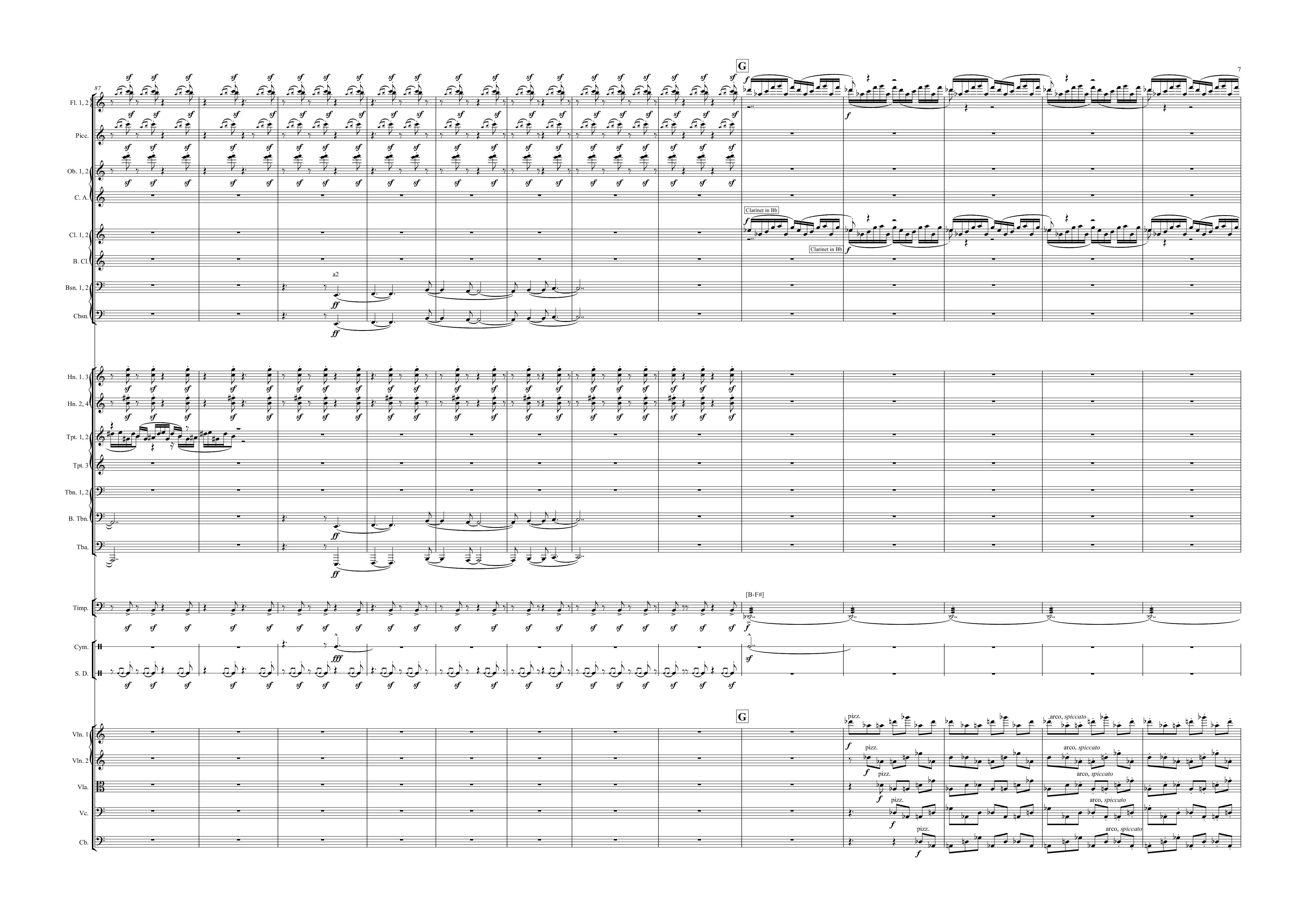
At C, the original row is transposed and augmented, with the different durations of the motif layered on top of each other, underneath a haunting fanfare, to signify the main section (pengawak). The fanfare is developed imitatively in a manner suggestive of kotekan, interlocking parts in the Gamelan style.
Up until this point, the timpani have been striking every 7 bars in the manner of Gongan, a regenerative gong which marks the renewal of the Gamelan musical cycle. At C, this expands to 8 bars, then is lost altogether at D by a stormy interruption.
D is marked by flashes of ‘lightening’, punctuated by the Piccolo, Oboes and Horns, which interrupt the moto perpetuo of the continuous raindrops. This is also reminiscent of the Gamelan syncopated accent called angsel. The strings move from col legno to spiccato, grading this transition to a fuller arco. These fuller textures are contrasted with ‘breakdown’ textures where the fanfare theme develops melodically and rhythmically, passing around the orchestra in the style of Klangfarbenmelodie. This has parallels with the telescoping of the musical energy in Lelambatan which follows the progress of the rituals.
E signifies a percussion break, with the Timpani and Snare in an increasingly heated dialogue of cross-rhythmic imitation over snarling Horns based on rotation 5 and a diminuted version of the row in rotation 3 (transposed up by a tone).
At F, a tremendous lightening sequence bursts this texture open, creating a Stravinsky-esque asymmetric pattern with thunderous Bass Trombone and Tuba underneath.
At G, the string raindrops return based on a rotation 4 transposition, cascading from pizzicato, through spiccato and finally to marcato. This transposition then proceeds to shift up and down according to the movement at the end of the ‘Bali’ motif (down a tone, up a tone, up a semitone), this quickened harmonic rhythm alluding to the build-up of this violent storm. ‘Windy’ flute and clarinet bursts of the row in rotation 5, the returning fanfare also herald the climax and asymmetric lightening also herald a climax.
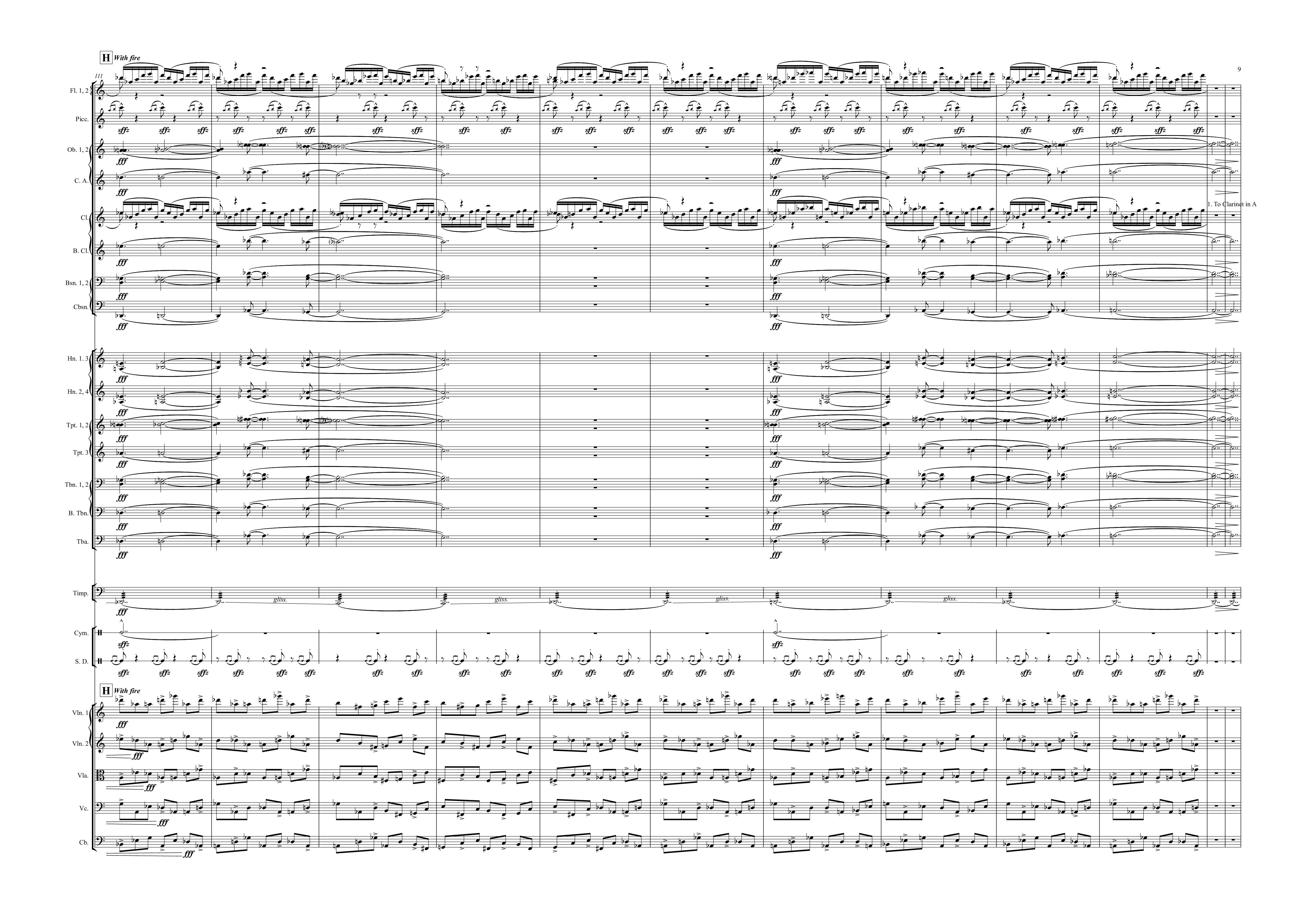
Finally, at H, the Bali motif bursts in forcefully scored for full brass, Oboes and Bassoons. The original rotation forms a vertical harmonic function, determining the chords which sit on top of this motif’s bassline.
The eye of the storm (coincidentally at I) gives us a suspenseful pause before bursting into the full glory of rotation 4 transposed to G#. The strings re-enter, this time with full legato bowing, a retrograde inversion of the original row and their metrical displacements also reversed. This represents that we have reached the backside of the hurricane. Eventually, the string parts begin to wane according to the minimalist technique of note subtraction and following the opposite pattern of their entry at the beginning. The brass and Bassoons briefly allude to former motifs in retrograde too, but the texture quickly evaporates to focus on the Alto Flute and Clarinet in A, which play the original Bali motif in retrograde before the end.
The storm finally disappears without a trace.
Praise from Dr. Michael Ellison and Professor John Pickard, University of Bristol:
This is a very well-conceived and orchestrated Balinese gamelan, Lelambatan inspired orchestral work. Dealing with a storm as it does, and colotomic cycles of rhythm articulated by timpani, within which a fast 7/8 builds and builds, the piece is exciting from beginning to end. Alto flute sets a ritualistic, serious tone, punctuated by a long rest, which is effective and adds to the tension of what’s to follow. The use of limited serial rotations is a natural fit with the five note pelog you base them on—with well chosen transformations (the ones with G# especially) of the original series/set. The step-by-step introduction of these arrays in overlapping, mainly interlocking and heterophonic texts works well in producing a ‘flat’ sense of large harmonic progression, which is at first very clear in its progression, and then becomes more collage-like and cumulative as horns insist on the original set in their punctuating four-note chords, while others introduce new material. You’ve also used 8ve bass lines, as work well in a gamelan style ‘draped’ under the meter extremely effectively, as at C for example.
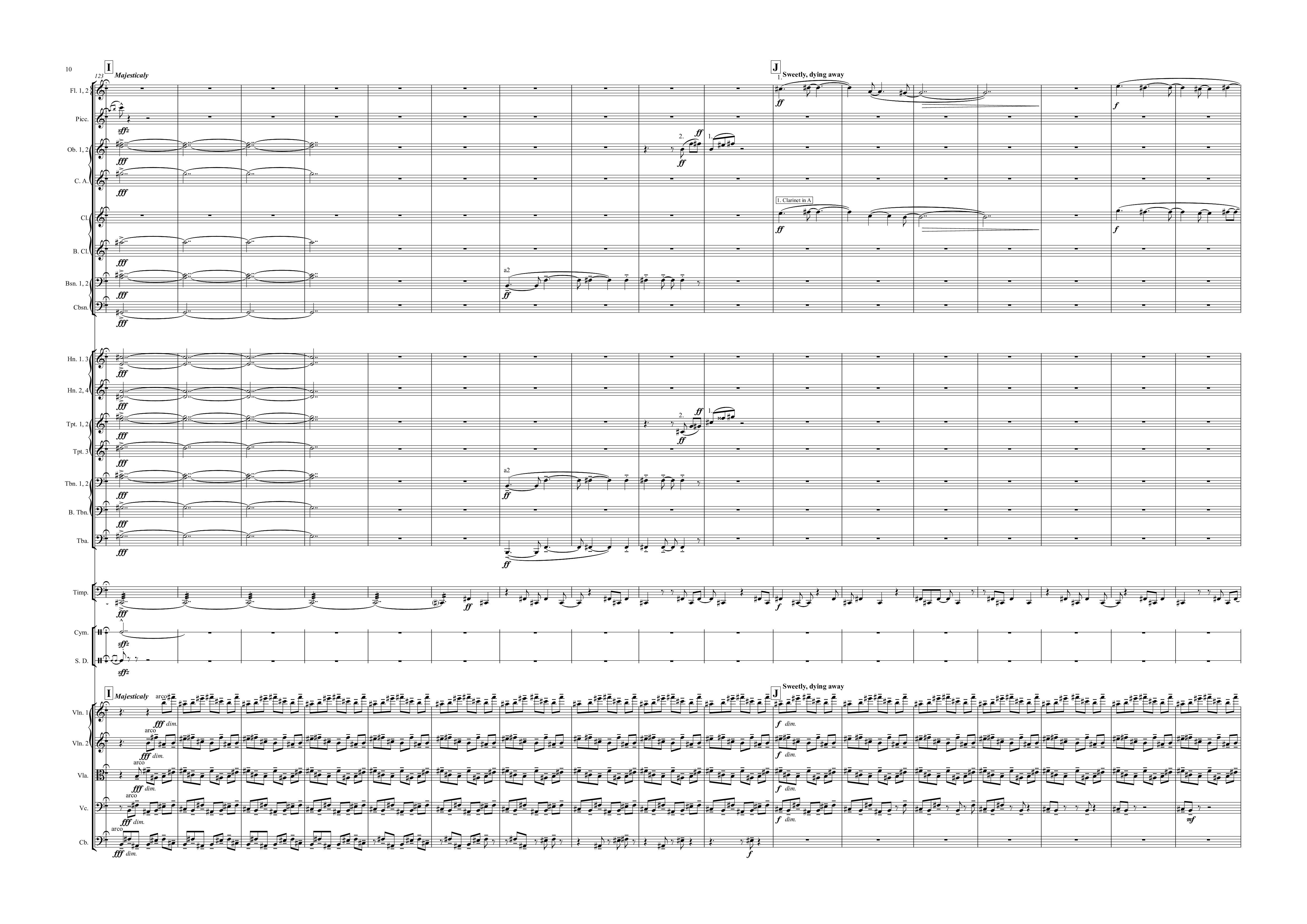
The orchestration itself is superb, if challenging: the interlocking works particularly well in trumpets and winds, and the col legno tone followed much later by tenuto bowings creates a sonic development in the piece also. Timpani is particularly well used, well beyond its original colotomic function. The dying away at the end one by one, almost as the fast part of the piece began, is extremely effective. You’re sometimes pushing the trumpets and flutes to their limits in terms of legato speed, and its always challenging for players to fit into the 7/8 in rotating ways, but it is very performable and will come off well. Good alternations of 1st and 2nd players too, in some of the trickier parts (e.g. bsn. at D). The buildup of massive sound at H followed by your ‘I’ of the storm also creates a surprising and welcome emotional shift, giving the piece a profile it would not have were it simply a ‘process’ piece.
The score is immaculately presented, and very clear throughout.